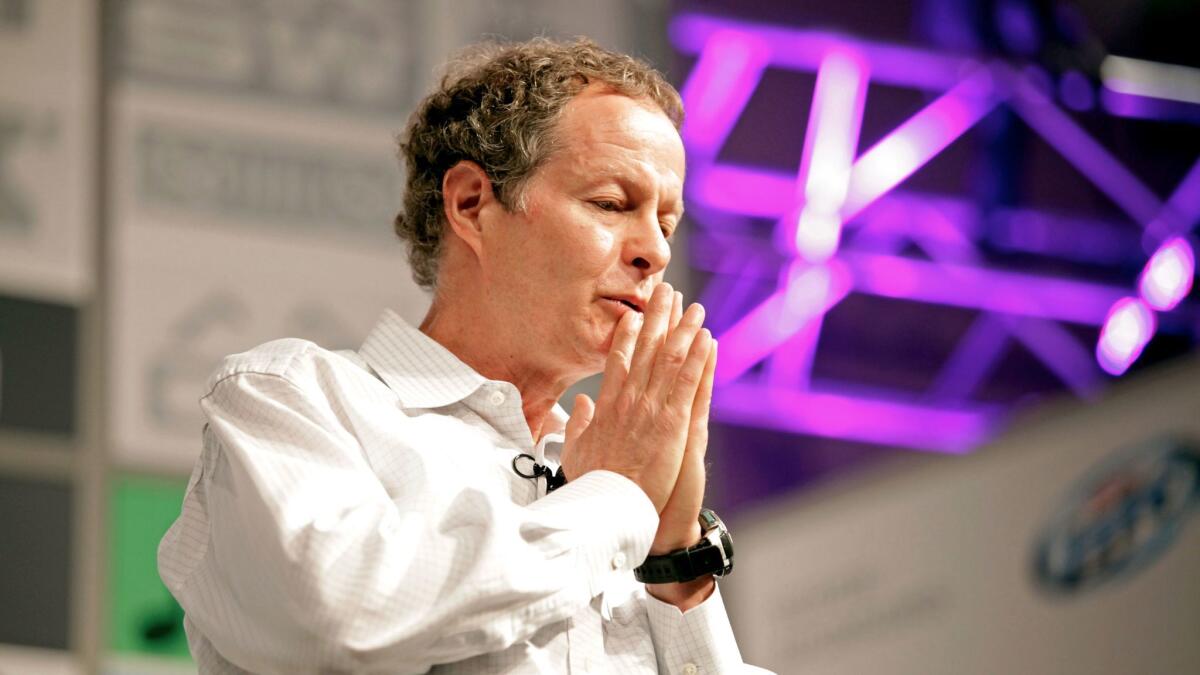Column: Will Amazon change the food business — or will the food business change Amazon?

Leave it to Amazon’s Jeff Bezos to shake up multiple industries with a single blockbuster press release.
Friday’s announcement that Amazon is buying grocery retailer Whole Foods Market for $13.7 billion in cash rattled grocery stocks, with Kroger, the owner of Ralphs and Food4Less, losing more than 9%; warehouse stores, which have expanded into grocery sales, were also down, Costco by more than 7% and Walmart by nearly 5%.
The entire e-commerce field similarly was thrown for a loop. As is often the case with Bezos’ initiatives, his goals and endgame remain murky.
Speculation centered on whether the deal heralds a full-scale incursion by Amazon into grocery retailing, a bear-hug for Whole Foods’ upscale suburban customer base, or an effort to collect and exploit consumer data held by grocery retailers and combine it with Amazon’s already vast hoard of information collected even more readily by its Echo voice-activated home device. Or is it merely an expression of Bezos’ desire for world retail domination?
To some observers, the Whole Foods acquisition is about Amazon’s expansion into online-order/home-delivery of groceries. To others, it’s about Amazon’s desire to reduce the need and expense of home deliveries of merchandise by bringing customers into its stores, which thus can function as centralized distribution points. (Sometimes one can find these contradictory viewpoints in separate articles from the same news source, a rather Amazonian phenomenon.)
One reason for the perplexity, other than Bezos’ habitual poker face, is that in terms of online potential, food is a qualitatively different product category from the physical and digital merchandise such as books, music and electronics that have been the traditional core of Amazon’s inventory. The latter are standardized — one copy of “David Copperfield” or set of Bose speakers is largely identical to any other; shoppers can judge their individual features by reading the snippets on Amazon’s book pages, listening to a brief musical passage on its website or exploiting the local Best Buy as a consumer products showroom before ordering from home.
The same can’t be said of supermarket wares. Processed foods are subject to quality control, but produce and meats are highly variable; will shoppers be willing to let Amazon’s pickers select their cantaloupes or will they still want to judge for themselves at the fruit bin? A distributor can’t hold a shipment of grapes in the warehouse indefinitely, like cartons of bestsellers; shipping perishables is the ultimate just-in-time challenge, requiring in-transit technologies such as refrigeration that don’t lend themselves to lowering costs.
These factors may explain why e-commerce has been slow to catch on in the grocery business. The Food Marketing Institute has estimated “online grocery spending” at about 4.3% of U.S. grocery sales, but that apparently includes online ordering, not necessarily remote delivery. By contrast, the share of all new U.S. book sales held by Amazon alone is more than 41%.
Amazon’s highest-profile venture into the grocery business is its “Amazon Go” convenience store, which allows shoppers to pick up food and beverage and charge the purchase automatically to their Amazon account without checking out. So far there’s only one Amazon Go in existence, open to the company’s employees near its Seattle headquarters. The company is also testing out deliveries of perishables and other foodstuffs via its AmazonFresh delivery service, currently only available in Seattle, Northern and Southern California, and the New York and Philadelphia regions. Delivery is free for orders over $40.
Whether these initiatives will be a beachhead in an Amazon effort to upend the grocery market as it did the book business is an open question — one raised a few months ago, as it happens, by John Mackey, the co-founder and co-CEO of Whole Foods. In an interview with Bloomberg BusinessWeek in January, Mackey predicted that the expense of expanding AmazonFresh would make it “Amazon’s Waterloo.”
What’s less arguable is that the Whole Foods acquisition will give Amazon a vast new array of consumer data to feed its voracious appetite for information about customer habits. The supermarket industry was an early adopter of frequent-shopper programs, which collected purchase records and allowed it to target promotions at the customers most likely to respond.
Amazon today vacuums up such data through multiple funnels and is constantly developing more. The company knows what its customers are buying online and who they’re buying for. Through wish lists and gift lists it knows their birthdays and anniversaries and those of their nearest and dearest. It knows what’s been bought by customers with similar tastes and uses that knowledge to push choices at each of them.
For privacy advocates, the most unnerving innovations may be Amazon’s Echo home devices, which are designed to be always-on and always-listening, ostensibly on the alert for voice commands. The latest iteration, the Echo Look, will have a camera that can be turned on by voice command (currently the $199.99 Look can be purchased only by Amazon’s invitation).
Do these devices tell Amazon too much? Thus far, the most pointed privacy concerns involve whether they harbor information that could be accessed by law enforcement with or without a warrant; Bezos himself has called for a public debate on the proper limits of such access.
Amazon characterizes much of this as information voluntarily handed over by customers, but it acknowledges it includes information they may not realize they’re giving away — “financial information, including Social Security and driver’s license numbers” — or data about unwary third parties — information about “people to whom purchases have been shipped, including addresses and phone number;… [and] e-mail addresses of your friends and other people.” The company says it doesn’t sell this data to others, but does sometimes share it with “affiliated businesses.” Now those affiliated businesses may include Whole Foods.
Keep up to date with Michael Hiltzik. Follow @hiltzikm on Twitter, see his Facebook page, or email [email protected].
Return to Michael Hiltzik’s blog.
More to Read
Inside the business of entertainment
The Wide Shot brings you news, analysis and insights on everything from streaming wars to production — and what it all means for the future.
You may occasionally receive promotional content from the Los Angeles Times.











